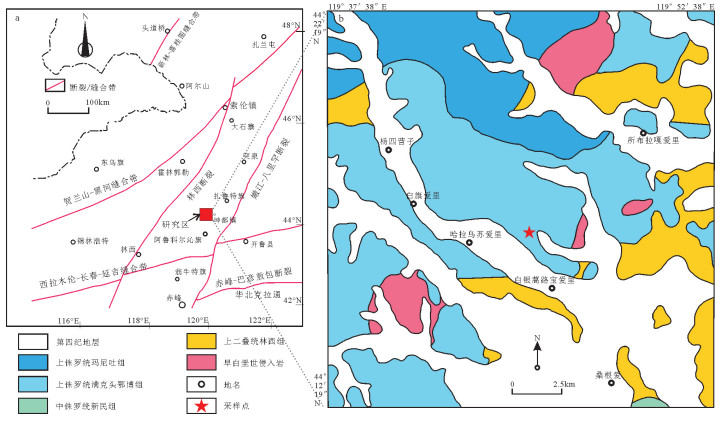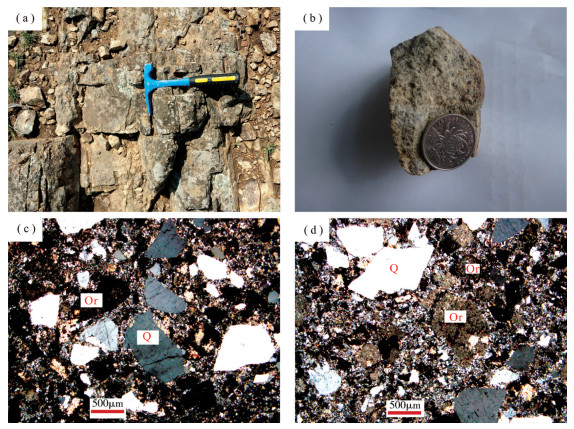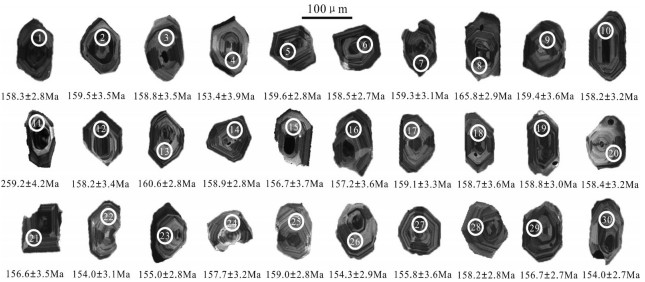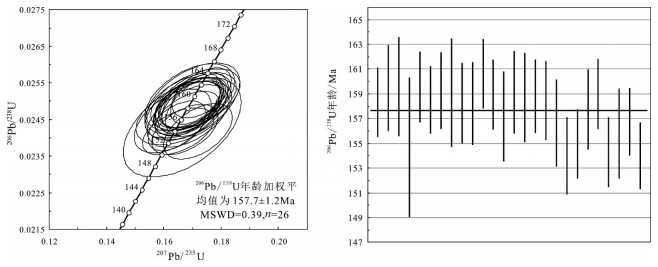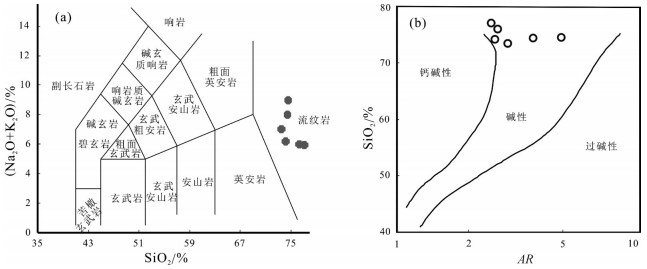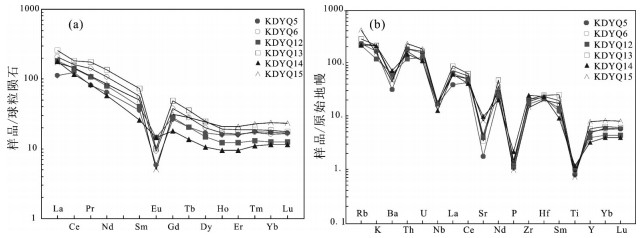Formation age and geochemical characteristics of volcanic rocks in Manketou'ebo Formation in Kundu area of Ar Horqin Banner, Inner Mongolia
-
摘要:
内蒙古赤峰市阿鲁科尔沁旗坤都地区满克头鄂博组火山岩为一套酸性火山熔岩与火山碎屑岩组合。用LA-ICP-MS技术测得流纹质晶屑凝灰岩中锆石的206Pb/238U年龄值为157.7±1.2Ma,时代为晚侏罗世晚期。地球化学分析结果显示,满克头鄂博组凝灰岩具有高Si、Al,低Ca、Mg的过铝质碱性火山岩特点,稀土元素配分曲线呈平缓右倾型,并具有明显的负Eu异常;富集大离子亲石元素Rb、K和高场强元素Th、U,亏损高场强元素Nb、Ti,反映火山岩为壳源成因类型。凝灰岩锆石εHf(t)=+2.6~+8.6,二阶段Hf模式年龄为590~925Ma,反映其源区物质主要为早古生代—新元古代增生的年轻地壳物质。满克头鄂博组凝灰岩具有A2型花岗岩特征,指示火山岩形成于造山后伸展环境,可能与蒙古-鄂霍茨克洋闭合造山后的岩石圈伸展作用密切相关。
Abstract:Volcanic rocks of Late Jurassic Manketou'ebo Formation in Kundu area of Inner Mongolia are mainly composed of a series of acid lava and volcaniclastic rocks. The LA-ICP-MS zircon U-Pb age is 157.7±1.2Ma (MSWD=0.39, n=26), which indicates its eruption in the late Late Jurassic. The geochemical analysis shows that these tuffs are peraluminous alkaline volcanic rocks with high Si, Al, low Ca, Mg, with the REE pattern gently inclined to the right and exhibiting negative Eu anomaly. The characteristics of trace elements suggest that the volcanic rocks are enriched in LILE (such as Rb and K) and HFSE (such as Th and U), and depleted in HFSE such as Nb and Ti, which implies that the source rocks are of crust genetic type. The zircons of the tuffs have εHf(t) values ranging from+2.6 to+8.6, with two-age Hf model age being 590~925Ma, which suggests that the magma for these volcanic rocks was derived from the newly accreted Early Paleozoic-Neoproterozoic juvenile crustal materials. The tuffs of Manketou'ebo Formation possess the characteristics of A2-type granites, indicating that they were formed in a post-orogenic extensional environment, which was possibly related to the lithosphere extension after the closure of the Mongol-Okhotsk Ocean.
-
Keywords:
- volcanic rock /
- A-type granites /
- geochemical analysis /
- Late Jurassic /
- Manketou'ebo Formation
-
锡石是锡多金属矿床中重要的矿石矿物,属于金红石族,当含有较高的U、Pb含量时,可以作为U-Pb和Pb-Pb同位素年龄测定的对象。利用锡石U-Pb同位素定年直接测定锡多金属矿床的成矿(锡矿化)时代,是非常有潜力的直接测定矿床成矿时代的方法。早在1992年便有人尝试利用热电离质谱(TIMS)法进行锡石U-Pb同位素年龄测定[1],以确定锡多金属矿床的成矿(锡矿化)时代。TIMS法是矿物U-Pb同位素年龄测定的经典方法,测定精度较高,是比较可靠的锡石U-Pb同位素测年方法[2-3]。但是,用传统的TIMS法进行锡石U-Pb同位素年龄测定时,需要进行非常复杂、费时的化学前处理工作,效率很低,直接影响了该方法的推广应用。近年来陆续有文献[4-10]报道了利用新发展起来的激光烧蚀电感耦合等离子体质谱仪(以下简称LA-ICP-MS)技术直接进行锡石微区原位U-Pb同位素及微量元素测定的新方法,并对这一新方法的优点、局限性等关键性问题进行了初步探讨[11-12]。其中,非放射成因初始普通铅的合理扣除和元素分馏效应的校正问题,是获得准确的LA-ICP-MS锡石U-Pb同位素年龄的关键问题。
与锆石相比,锡石的非放射成因初始普通铅含量较高,且分布不均一,同一锡石样品中不同锡石颗粒或同一锡石颗粒中不同晶域的非放射成因初始普通铅含量都可能有较大差异。用LAICP-MS法直接进行锡石的原位U-Pb同位素年龄测定时,应尽可能挑选锡石中非放射成因初始普通铅含量较低的颗粒或晶域进行测定,尽可能采用非放射成因初始普通铅含量较低的数据进行年龄计算。在难以通过其他方法准确测定锡石中非放射成因初始普通铅的同位素组成,难以准确扣除单次测定的非放射成因初始普通铅时,用UPb或Pb-Pb等时线法或谐和图法整体性扣除多次测定的非放射成因初始普通铅,并计算锡石的U-Pb或Pb-Pb同位素年龄,不失为准确扣除非放射成因初始普通铅并获得准确的锡石U-Pb同位素年龄的好方法。
近年来部分地质工作者在报道和使用锡石及其他一些类似的非锆石类含铀矿物U-Pb同位素年龄数据时[13-21],由于对矿物微区原位U-Pb同位素年龄测定时的初始普通铅合理扣除,以及元素分馏效应的校正问题存在不同的认识,导致对数据处理方法和测定结果的理解产生分歧,甚至导致一些论文和数据资料的发表受阻。本文主要根据笔者的研究成果,结合近年来文献报道的资料,以及一些具体的例子,对锡石微区原位LA-ICP-MS U-Pb同位素定年中初始普通铅扣除的2种主要方法,即谐和图法和等时线法的原理、效果、方法的优点和局限性、针对具体样品选择扣除方法的基本原则等问题进行深入讨论,并对类似的非锆石类含铀矿物微区原位LA-ICP-MS U-Pb同位素年龄测定中的初始普通铅扣除方法进行探讨。希望能对广大地质工作者利用LA-ICP-MS锡石U-Pb同位素定年技术测定各种锡多金属矿床成矿时代的工作有所帮助。
1. 测试方法及样品
1.1 测试仪器及方法
测试工作均在中国地质调查局天津地质矿产研究所同位素实验室进行,所用仪器为一套激光烧蚀多接收器电感耦合等离子体质谱仪(LA-MCICP-MS)。该套系统的多接收器电感耦合等离子体质谱仪为Thermo Fisher公司制造的Neptune,其离子光学通路采用能量聚焦和质量聚焦的双聚焦设计,并采用动态变焦使质量色散达到17%;仪器配有9个法拉第杯接收器和4个离子计数器接收器,除了中心杯和离子计数器外,其余8个法拉第杯配置在中心杯的两侧,并以马达驱动进行精确的位置调节,4个离子计数器捆绑在L4法拉第杯上。激光器为美国ESI公司生产的UP193-FX ArF准分子激光器,激光波长193nm,脉冲宽度5ns,束斑直径在2μm、10μm、20μm、35μm、50μm、75μm、76μm、100μm、150μm等数值中选择,脉冲频率1~200Hz连续可调。
具体的测试方法为:首先对待测锡石制靶、抛光、照相。其中包括对靶上样品进行显微镜下的反射光和透射光照相及阴极发光成像[22],根据透射光和反射光及锡石阴极发光照片,选择锡石的合适晶域进行测定。在上机测试时,利用193nm激光器对锡石进行剥蚀,通常采用的激光剥蚀斑束为35μm、50μm或75μm,激光能量密度为10~13J/cm2,频率为8~10Hz(表 1),激光剥蚀物质以氦为载气送入Neptune,利用动态变焦扩大色散,使质量数相差很大的U、Pb同位素可以同时接收,从而进行锡石U-Pb同位素微区原位测定。采用实验室锡石工作标样作为外部标准锡石。测定前先用锆石标样作为一次标准校准仪器状态,然后再用实验室锡石工作标样作为二次标准与所测定的锡石样品交替进行测定。根据经验,每测定5~10次样品,需测定3~5次工作标样。数据处理方面,采用中国地质大学刘勇胜博士研发的ICPMSData-Cal程序[23]和Ludwig的Isoplot程序[24]进行数据处理。利用NIST610作为外标计算锡石样品的Pb、U、Th含量。
表 1 锡石LA-MC-ICP-MS U-Pb同位素测定的接收器配置及相关仪器参数Table 1. Machine conditions and protocols for cassiterite LA-MC-ICP-MS U-Pb analysisL4 L3 L2 L1 C H1 H2 H3 H4 204Pb 207Pb206Pb 208Pb 208Pb 2019.26 232Th 238U 冷却气体 16L/min 辅助气体 0.75L/min 裁气(氩) 0.968L/min 载气(氦) 0.86L/min RF功率 1251W 积分时间 0.131s 样品信号采集时间 60s(15~20s空白) 激光能量密度 10~13J/cm2 剥蚀斑径 32pm、50pm或75pm 激光频率 8~10Hz 1.2 测试样品
本次共选取了2件测试样品,第1件为中国湖南芙蓉锡矿的一个锡石样品(编号:AY-4)。有关该锡石样品的地质背景、精确的热电离质谱法UPb同位素定年结果和微区原位LA-ICP-MS UPb同位素定年结果及定年结果的地质解释等资料见参考文献[5]。在对此样品进行测试时,选取已获得精确TIMS法年龄结果的锡石样品(编号:WCP2-2,其TIMS法所得的年龄结果为157.8Ma)作为工作标样,并对AY-4获得的数据进行校正。第2件测试样品为采自中国湖南省永州市金洞管理区老寨岭矿区锡矿的一个锡石样品(编号:LZ-07)。有关该锡石样品的地质背景、定年结果的地质解释等另文报道。在对该样品进行测试时,选取锡石AY-4作为标准样品并对LZ-07获得的数据进行校正。选择AY-4作为锡石标样,是因为在目前分析研究的众多锡石样品中,AY-4是其中U、Pb含量较高、较为稳定,样品量较大,并且也获得了非常精确的TIMS法年龄结果的一个锡石样品(TIMS法所得的年龄为158.2Ma)。该锡石样品目前已成为本实验室最为常用的锡石工作标样之一。
2. 测试结果及讨论
对所选锡石样品的测试数据,分别用谐和图法和等时线法进行非放射成因初始普通铅的扣除、元素分馏效应的校正等数据处理,并计算年龄结果。在对测试结果进行比较和讨论之前,首先对用谐和图法和等时线法进行非放射成因初始普通铅扣除和元素分馏效应校正的原理、效果、方法的优点和局限性进行简要的讨论。
2.1 扣除非放射成因初始普通铅的谐和图法和等时线法简介
2.1.1 谐和图法
谐和图是显示U-Pb同位素定年数据并对其进行图解法计算年龄的图件,常用的有传统的谐和图(Concordia diagram)和Tera-Wasserburg的谐和图(Tera-Wasserburg diagram,有的中文文献[25]称之为逆谐和图)。U-Pb同位素定年技术是应用最广的同位素定年技术之一,具有其他许多同位素测年技术无法相比的优点。其中最突出的优点在于可以同时利用2个同位素衰变系列(即238U-206Pb和235U-207Pb衰变系列)进行测年,获得3个独立的同位素年龄(即206Pb/238U年龄、207Pb/235U年龄和207Pb/206Pb年龄),因而测年结果可以进行内部校正。这一优点源于U-Pb同位素定年的基本原理:矿物中的U同位素(238U和235U)经放射性衰变生成稳定同位素(206Pb和207Pb)。通过对试样中母体同位素(238U和235U)和子体同位素(206Pb和207Pb)含量及Pb同位素比值的测定,即根据放射性衰变定律,计算试样形成封闭体系以来的时间,即矿物形成以来的年龄, 包括206Pb/238U年龄、207Pb/235U年龄和207Pb/206Pb年龄。如果这3个年龄在测定误差范围内一致,说明矿物形成以来其U-Pb同位素系统是封闭的,其U-Pb同位素年龄是谐和的,这3个年龄中的任何一个都可以代表矿物形成的年龄;否则说明矿物形成以来U-Pb同位素系统是开放的,其U-Pb同位素年龄是不谐和的,需要进行内部校正才能获得正确的矿物形成年龄。通常采用传统的谐和图或Tera-Wasser-burg谐和图来进行这样的校正,这在锆石U-Pb同位素年龄测定的数据处理和年龄计算中已被广泛采用。传统的谐和图或Tera-Wasserburg谐和图中的谐和曲线(Concordia curve)是3个表面年龄在测定误差范围内相一致的点的轨迹,也就是说,在谐和曲线上的所有点,3个表面年龄在测定误差范围内是一致的。通常将样品的实际测定数据进行非放射成因初始普通铅扣除和元素分馏效应校正后再投点在谐和图中。如果样品的实际测定数据点偏离谐和曲线,说明样品的U-Pb同位素系统是开放的,其U-Pb同位素年龄是不谐和的,需要进行内部校正才能获得正确的矿物形成年龄。这样的内部校正通常包括一组测定数据点拟合成的不一致线与谐和曲线的上交点和下交点年龄。
用谐和图法进行非放射成因初始普通铅扣除,是将未经非放射成因初始普通铅扣除的实际测定数据直接投点在谐和图(通常用Tera-Wasserburg的谐和图)中,并假定样品的实际测定数据点偏离谐和曲线的主要原因是非放射成因普通铅的加入。对同一矿物样品的不同颗粒或同一颗粒的不同晶域进行测定,得到的多个数据点如果都偏离谐和曲线,但是在谐和图中能够沿一条直线分散排列,便可以假定测定的矿物样品具有相同的U-Pb同位素年龄,只是其中的普通铅相对含量不同。将这样的多个数据点连成一条直线,这一直线与谐和曲线的下交点,便是该矿物样品扣除普通铅后(普通铅含量为零)的U-Pb同位素年龄。由于扣除普通铅后的U-Pb同位素年龄是谐和年龄,即其206Pb/238U年龄、207Pb/235U年龄和207Pb/206Pb年龄这3个年龄在测定误差范围内一致,而207Pb/206Pb年龄是不存在元素分馏效应的,因此采用206Pb/238U年龄或207Pb/235U年龄也就基本扣除了元素分馏效应。亦即,采用谐和图法进行非放射成因初始普通铅扣除时,可以同时扣除元素分馏效应。这一方法在计算一些普通铅含量稍高的锆石样品年龄时得到了较好的应用。有文献[26]报道,对于普通铅含量较高(普通铅含量为总铅含量的5%~40%)的锆石采用谐和图法进行非放射成因初始普通铅扣除,获得青藏高原年轻碱性玄武岩精确锆石U-Pb同位素年龄(3.8Ma)。但是对于普通铅含量更高(普通铅含量为总铅含量的50%以上)的锡石、磷灰石等矿物,用谐和图法进行非放射成因初始普通铅扣除有时会导致较大的年龄误差。
2.1.2 等时线法
等时线法最初用于Rb-Sr同位素年龄的计算。因为在岩石或矿物结晶时,总有一定数量的普通锶进入其中,给准确测定样品中放射成因锶的含量造成很大困难,因此通常采用等时线法来计算岩石或矿物的Rb-Sr同位素年龄。后来许多学者提出采用与Rb-Sr等时线相类似的图解法,即采用206Pb/204Pb-238U/204Pb、207Pb/204Pb-235U/204Pb、208Pb/204Pb-232Th/204Pb和206Pb/204Pb-207Pb/204Pb等时线图研究一组同时、同源样品的U-Pb同位素年龄,如果这组样品保持封闭的U-Pb同位素体系,并具有相同的初始值,就可以获得相应的等时线,该等时线的斜率代表样品的年龄[27]。Brian等[1]最初用热电离质谱(TIMS)法进行锡石U-Pb同位素年龄测定时,采用等时线法,用206Pb/204Pb-238U/204Pb等时线图成功获得了较年轻,且普通铅含量较高的锡石U-Pb同位素年龄[28]。
在锡石微区原位LA-ICP-MS U-Pb同位素年龄测定中,因为204Pb信号很小,加上使用的载气(氦气)中往往含有204Hg,204Hg信号对204Pb信号产生干扰,204Pb信号很难测准,故一般不测204Pb。锡石样品普通铅含量较高而且不均匀,颗粒与颗粒之间差异很大,用208Pb扣除法也不能很好地扣除普通铅。而207Pb的信号约是204Pb的15倍,比较容易测准,加上238U含量为235U含量的137.88倍,对于较年轻(如小于400Ma)且普通铅含量较高的锡石,由235U衰变形成的放射成因207Pb*很少,当207Pb*含量占207Pb总量少于2%时,207Pb主要为普通铅中的207Pb,放射成因207Pb*可以忽略不计,那么206Pb/204Pb-238U/204Pb等时线图可以改为206Pb/207Pb-238U/207Pb等时线图,用于研究年龄较轻(如小于400Ma)且普通铅含量较高的锡石微区原位LA-ICP-MS U-Pb同位素年龄。对于普通铅含量较低的锡石样品,由于207Pb含量较低,207Pb信号较小,不易测准,用206Pb/207Pb-238U/207Pb等时线图获得的等时线年龄误差较大。另外,206Pb/207Pb-238U/207Pb等时线图只适用于计算较年轻(如小于400Ma)的锡石样品U-Pb同位素年龄,不适用于计算较老(如大于400Ma)的锡石样品的UPb同位素年龄,因为随着锡石样品年龄的增大,其中放射成因207Pb*的含量也会增大,放射成因207Pb*影响就不能忽略不计,而放射成因207Pb*的影响的增大会导致206Pb/207Pb-238U/207Pb等时线图获得的等时线年龄误差增大。
与谐和图法普通铅扣除不同,用等时线法扣除普通铅时并没有考虑元素分馏效应的影响,因此对于用等时线法扣除普通铅后得到的等时线年龄,需要再进行元素分馏效应的校正,才能获得准确的U-Pb同位素年龄。
2.2 测试样品AY-4的数据及结果
测试样品AY-4时选取WCP2-2作为锡石标样,WCP2-2的LA-ICP-MS测试数据见表 2,年龄结果见图 1和图 2,其中图 1为用谐和图法扣除普通铅得到的结果,图 2为用等时线法扣除普通铅得到的结果。
表 2 锡石WCP2-2 LA-MC-ICP-MS U-Pb同位素测试数据Table 2. LA-MC-ICP-MS U-Pb isotopic data for cassiterite WCP2-2样品号及测试点 同位素比值 238U/206Pb err% 206Pb/207Pb err% 38U/207Pb err% WCP2-2.1 11.30 8.05 1.53 2.06 17.33 8.05 WCP2-2.2 11.08 4.08 1.51 0.91 16.70 4.08 WCP2-2.3 12.15 3.08 1.56 0.78 18.98 3.08 WCP2-2.4 19.90 2.42 1.97 1.00 39.23 2.42 WCP2-2.5 8.72 3.37 1.43 0.60 12.46 3.37 WCP2-2.6 33.67 2.70 3.49 1.85 117.46 2.70 WCP2-2.7 3.79 0.99 1.28 0.13 4.83 0.99 WCP2-2.8 21.86 3.09 2.11 1.35 46.11 3.09 WCP2-2.9 45.40 5.99 14.82 5.67 672.83 5.99 WCP2-2.10 4.44 1.86 1.29 0.18 5.73 1.86 WCP2-2.11 23.25 2.30 2.12 1.08 49.35 2.30 WCP2-2.12 1.16 5.28 1.21 0.09 1.41 5.28 WCP2-2.13 28.64 3.96 2.81 2.29 80.58 3.96 WCP2-2.14 9.94 3.26 1.47 0.66 14.60 3.26 WCP2-2.15 33.59 1.49 3.55 0.99 119.29 1.49 WCP2-2.16 4.20 3.68 1.33 0.70 5.57 3.68 WCP2-2.17 3.49 2.96 1.26 0.21 4.39 2.96 WCP2-2.18 43.60 3.43 10.85 3.19 472.98 3.43 WCP2-2.19 43.24 2.81 9.15 2.47 395.75 2.81 WCP2-2.20 6.17 0.93 1.35 0.24 8.33 0.93 WCP2-2.21 19.70 3.97 1.95 1.55 38.44 3.97 WCP2-2.22 2.79 0.87 1.25 0.09 3.49 0.87 WCP2-2.23 15.72 5.11 1.73 1.64 27.21 5.11 WCP2-2.24 18.47 2.45 1.87 0.91 34.59 2.45 WCP2-2.25 4.28 2.22 1.29 0.21 5.52 2.22 WCP2-2.26 7.98 2.22 1.4 0.37 11.15 2.22 WCP2-2.27 9.41 7.20 1.44 1.32 13.56 7.2 WCP2-2.28 33.71 2.92 3.73 2.03 125.81 2.92 WCP2-2.29 23.03 5.56 2.18 2.5 50.31 5.56 WCP2-2.30 37.12 1.30 4.73 1.04 175.47 1.3 WCP2-2.31 22.46 2.16 2.12 0.97 47.74 2.16 WCP2-2.32 2.30 2.23 1.23 0.11 2.84 2.23 WCP2-2.33 39.28 6.12 6.27 5.11 246.3 6.12 WCP2-2.34 18.90 1.04 1.92 0.41 36.32 1.04 WCP2-2.35 14.19 1.51 1.64 0.43 23.25 1.51 WCP2-2.36 4.65 2.41 1.29 0.43 5.99 2.41 WCP2-2.37 2.98 1.76 1.25 0.1 3.73 1.76 WCP2-2.38 20.59 4.22 1.98 1.69 40.76 4.22 WCP2-2.39 5.23 1.86 1.31 0.19 6.85 1.86 WCP2-2.40 16.57 3.56 1.75 1.19 28.97 3.56 WCP2-2.41 46.85 2.67 19.01 2.56 890.66 2.67 WCP2-2.42 7.03 0.88 1.36 0.18 9.57 0.88 WCP2-2.43 28.75 3.26 2.77 1.9 79.74 3.26 WCP2-2.44 13.59 5.76 1.65 1.74 22.38 5.76 WCP2-2.45 23.55 2.14 2.25 1.06 53.1 2.14 WCP2-2.46 15.12 3.03 1.72 0.99 25.99 3.03 WCP2-2.47 9.71 8.85 1.45 1.59 14.07 8.85 WCP2-2.48 25.29 2.56 2.42 1.34 61.3 2.56 WCP2-2.49 40.70 2.37 6.65 1.96 270.76 2.37 根据实测的锡石标样WCP2-2的数据结果及其TIMS法所得的年龄结果157.8Ma,计算出不同方法扣除普通铅得到的不同的校正系数K值(K=TIMS法年龄结果/实测年龄结果)。用谐和图法扣除普通铅得到的校正系数K值,K1=157.8/136.6=1.16;用等时线法扣除普通铅得到的校正系数K值,K2=157.8/128.3=1.23。用谐和图法扣除普通铅得到的校正系数K值与用等时线法扣除普通铅得到的K值不同,是因为用谐和图法进行非放射成因初始普通铅扣除时,同时也扣除了元素分馏效应,其校正系数K值仅包括对仪器测定系统误差的校正;而用等时线法扣除普通铅时,并没有扣除元素分馏效应,对于用等时线法扣除普通铅后得到的等时线年龄,需要再进行元素分馏效应的校正,才能获得准确的U-Pb同位素年龄,其校正系数K值不仅包括对仪器测定系统误差的校正,还包括对元素分馏效应的校正。因此,用谐和图法扣除普通铅得到的校正系数K值小于用等时线法扣除普通铅得到的校正系数K值。根据计算得到的不同的校正系数K值,对测试样品AY-4测得的数据进行校正,校正后的数据见表 3,处理后的年龄结果见图 3和图 4,其中图 3为用谐和图法扣除普通铅得到的处理结果,图 4为用等时线法扣除普通铅得到的处理结果。
表 3 锡石AY-4 LA-MC-ICP-MS U-Pb同位素校正后的数据Table 3. LA-MC-ICP-MS U-Pb isotopic corrected data for cassiterite AY-4样品测试点 同位素比值 谐和图法系数
K1=157.8/136.6238U/206Pb err% 207Pb/206Pb err% 等时线法系数
K2=157.8/128.3206Pb/207Pb err% 238U/207Pb err% AY-4.1 1.16 25.16 1.88 0.33 1.02 1.23 72.71 1.88 3.08 1.02 AY-4.2 1.16 37.82 1.12 0.07 1.11 1.23 485.02 1.12 13.65 1.11 AY-4.3 1.16 37.48 2.03 0.10 1.80 1.23 369.52 2.03 10.49 1.8 AY-4.4 1.16 36.63 2.01 0.12 1.80 1.23 287.28 2.01 8.35 1.8 AY-4.5 1.16 15.03 2.32 0.50 1.26 1.23 28.22 2.32 2.00 1.26 AY-4.6 1.16 35.14 1.50 0.12 1.23 1.23 277.96 1.50 8.42 1.23 AY-4.7 1.16 29.45 1.38 0.23 1.17 1.23 119.07 1.38 4.30 1.17 AY-4.8 1.16 38.63 1.54 0.06 1.40 1.23 597.65 1.54 16.47 1.4 AY-4.9 1.16 15.03 0.65 0.49 0.45 1.23 28.71 0.65 2.03 0.45 AY-4.10 1.16 28.20 3.74 0.23 2.76 1.23 117.06 3.74 4.42 2.76 AY-4.11 1.16 21.31 5.07 0.43 2.86 1.23 46.46 5.07 2.32 2.86 AY-4.12 1.16 39.19 2.30 0.07 2.31 1.23 559.52 2.30 15.20 2.31 AY-4.13 1.16 9.14 7.12 0.55 1.94 1.23 15.73 7.12 1.83 1.94 AY-4.14 1.16 37.32 2.92 0.09 2.76 1.23 398.44 2.92 11.37 2.76 AY-4.15 1.16 39.58 0.98 0.05 0.99 1.23 691.61 0.98 18.60 0.99 AY-4.16 1.16 35.58 1.21 0.14 1.02 1.23 236.17 1.21 7.07 1.02 AY-4.17 1.16 36.97 4.42 0.08 3.41 1.23 435.51 4.42 12.54 3.41 AY-4.18 1.16 18.20 3.67 0.44 1.97 1.23 38.81 3.67 2.27 1.97 AY-4.19 1.16 31.15 5.95 0.21 3.98 1.23 140.49 5.95 4.80 3.98 AY-4.20 1.16 36.33 1.83 0.14 1.54 1.23 0.17 19.10 1.15 1.29 AY-4.21 1.16 13.09 4.92 0.47 2.33 1.23 239.58 1.83 7.02 1.54 AY-4.22 1.16 34.89 1.90 0.15 1.53 1.23 25.89 4.92 2.11 2.33 AY-4.23 1.16 34.00 2.72 0.17 2.41 1.23 212.63 1.90 6.49 1.53 AY-4.24 1.16 22.52 1.38 0.39 0.82 1.23 189.14 2.72 5.92 2.41 AY-4.25 1.16 31.49 2.65 0.21 1.88 1.23 54.51 1.38 2.58 0.82 AY-4.26 1.16 17.86 5.32 0.41 2.41 1.23 144.10 2.65 4.87 1.88 AY-4.27 1.16 33.81 1.48 0.18 1.16 1.23 40.71 5.32 2.43 2.41 AY-4.28 1.16 31.76 2.64 0.22 2.01 1.23 176.00 1.48 5.54 1.16 AY-4.29 1.16 30.30 1.65 0.25 1.20 1.23 137.49 2.64 4.61 2.01 AY-4.30 1.16 14.89 4.58 0.50 1.71 1.23 114.41 1.65 4.02 1.2 AY-4.31 1.16 25.55 2.10 0.34 1.36 1.23 28.14 4.58 2.01 1.71 AY-4.32 1.16 17.09 2.29 0.50 0.91 1.23 71.03 2.10 2.96 1.36 AY-4.33 1.16 34.43 2.26 0.15 1.83 1.23 32.11 2.29 2.00 0.91 2.3 测试锡石样品LZ-07的数据及结果
测试锡石样品LZ-07时选取AY-4作为锡石标样(为了便于区分,在以下AY-4作为标样使用时名称改用ay-4),ay-4测试数据见表 4,年龄结果见图 5和图 6,其中图 5为用谐和图法扣除普通铅得到的处理结果,图 6为用等时线法扣除普通铅得到的处理结果。
表 4 锡石ay-4 LA-MC-ICP-MS U-Pb同位素测试数据Table 4. LA-MC-ICP-MS U-Pb isotopic data for cassiterite ay-4样品号及测试点 同位素比值 238U/206Pb err% 206Pb/207Pb err% 238U/207Pb err% ay-4.1 39.50 0.62 531.93 7.74 13.61 7.33 ay-4.2 36.81 1.65 265.23 10.66 7.59 9.03 ay-4.3 39.45 0.91 606.49 10.05 15.42 10.01 ay-4.4 40.73 0.16 761.54 2.48 18.70 2.45 ay-4.5 40.16 0.51 542.88 6.58 13.57 6.42 ay-4.6 30.27 1.87 111.60 5.71 3.72 5.05 ay-4.7 38.34 0.92 478.88 10.56 12.47 10.65 ay-4.8 32.00 1.55 244.37 10.33 7.98 6.32 ay-4.9 35.52 2.74 332.73 23.38 10.88 12.70 ay-4.10 29.99 1.25 135.90 3.80 4.60 2.78 ay-4.11 36.72 1.39 377.03 12.65 10.92 9.39 ay-4.12 36.84 1.34 396.03 13.21 11.46 9.85 ay-4.13 34.24 1.62 221.07 9.41 6.80 6.43 ay-4.14 37.57 0.54 433.53 6.63 11.65 6.12 ay-4.15 27.27 4.03 86.97 10.90 3.35 5.72 ay-4.16 26.75 2.44 86.55 6.42 3.4 3.84 ay-4.17 37.03 0.55 325.13 4.2 8.78 4.16 ay-4.18 18.77 5.45 49.18 11.56 2.67 6.78 ay-4.19 23.9 3.69 89.16 14.52 3.77 12.09 ay-4.20 29.76 3.96 144.11 16.45 5.72 9.1 ay-4.21 34.13 0.89 289.78 6.42 8.52 6.13 ay-4.22 33.64 1.02 225.88 5.47 6.79 4.86 ay-4.23 24.53 3.15 71.92 8.11 2.98 5.35 ay-4.24 38.65 0.47 487.8 4.98 12.64 4.88 ay-4.25 36.93 0.82 308.1 6.64 8.47 5.7 ay-4.26 32.41 0.82 145.79 3.12 4.51 2.57 ay-4.27 36.49 1.87 246.2 11.32 7.19 7.77 ay-4.28 40.2 0.16 691.2 3.04 17.2 2.99 ay-4.29 36.26 0.73 292.97 6.99 8.23 6.06 ay-4.30 35.65 1.27 246.42 8.5 7.11 7.05 根据实测的锡石标样ay-4的数据结果及TIMS法所得的年龄结果158.2Ma,对测试样品LZ-07所测得的数据进行校正,校正后的数据见表 5,其中用谐和图法扣除普通铅得到的校正系数K值,K1=158.2/157.7=1.003;用等时线法扣除普通铅得到的校正系数K值,K4=158.2/147.2=1.07。处理后的年龄结果见图 7和图 8,其中图 7为用谐和图法扣除普通铅得到的处理结果,图 8为用等时线法扣除普通铅得到的处理结果。
表 5 锡石LZ-07 LA-MC-ICP-MS U-Pb同位素校正后的数据Table 5. LA-MC-ICP-MS U-Pb isotopic corrected data for cassiterite LZ-07样品号及测试点 同位素比值 谐和图法系数
K3=158.2/157.7238U/206Pb err% 207Pb/206Pb err% 等时线法系数
K4=158.2/147.2206Pb/207Pb err% 238U/207Pb err% LZ-07.1 1.003 24.28 0.92 0.10 8.22 1.07 212.94 9.05 9.59 8.22 LZ-07.2 1.003 25.69 1.36 0.08 11.44 1.07 283.16 11.6 11.84 11.44 LZ-07.3 1.003 11.59 0.59 0.54 0.43 1.07 20.11 0.96 1.86 0.43 LZ-07.4 1.003 25.72 1.58 0.12 10.41 1.07 207.04 10.76 8.65 10.41 LZ-07.5 1.003 27.22 0.51 0.08 4.98 1.07 309.39 5.02 12.18 4.98 LZ-07.6 1.003 27.10 1.34 0.09 13.45 1.07 295.61 13.62 11.71 13.45 LZ-07.7 1.003 3.03 4.52 0.80 5.20 1.07 3.59 4.2 1.25 5.2 LZ-07.8 1.003 27.04 0.59 0.08 6.10 1.07 301.33 6.4 11.96 6.1 LZ-07.9 1.003 27.46 0.47 0.08 4.61 1.07 326.39 4.82 12.77 4.61 LZ-07.10 1.003 26.10 0.84 0.13 4.17 1.07 188.88 4.35 7.76 4.17 LZ-07.11 1.003 27.05 1.00 0.10 11.71 1.07 247.59 11.87 9.83 11.71 LZ-07.12 1.003 23.54 1.00 0.20 5.11 1.07 108.87 5.16 4.95 5.11 LZ-07.13 1.003 25.15 0.68 0.16 3.49 1.07 142.49 3.81 6.08 3.49 LZ-07.14 1.003 9.31 2.33 0.60 1.12 1.07 14.52 3.17 1.67 1.12 LZ-07.15 1.003 27.22 1.19 0.09 10.85 1.07 277.55 11.14 10.97 10.85 LZ-07.16 1.003 28.09 0.43 0.07 6.09 1.07 381.31 6.17 14.56 6.09 LZ-07.17 1.003 27.09 0.69 0.10 4.91 1.07 245.48 5.61 9.81 4.91 LZ-07.18 1.003 27.59 0.47 0.10 3.71 1.07 269.14 3.92 10.47 3.71 LZ-07.19 1.003 27.50 0.39 0.08 5.19 1.07 341.15 5.22 13.29 5.19 LZ-07.20 1.003 4.20 6.33 0.81 6.77 1.07 5.01 4.79 1.24 6.77 LZ-07.21 1.003 28.26 0.35 0.09 2.67 1.07 308.2 3 11.71 2.67 LZ-07.22 1.003 25.75 0.99 0.16 5.66 1.07 152.45 6.15 6.39 5.66 LZ-07.23 1.003 25.26 1.90 0.15 7.86 1.07 145.64 10.14 6.52 7.86 2.4 数据处理结果的比较和讨论
从以上2种不同方法进行普通铅扣除得到的最终数据结果可以看出,AY-4采用谐和图法处理所得年龄结果为160.0±3.5Ma,采用等时线法处理所得年龄结果为159.9±1.9Ma;LZ-07采用谐和图法处理所得年龄结果为223.1±3.3Ma,采用等时线法处理所得年龄结果为223.0±4.2Ma。也就是说,对于较年轻(如小于400Ma)的锡石样品,同一个样品的同一组测定数据,用2种不同方法进行普通铅扣除得到的结果在误差范围内完全一致。但是,对于普通铅含量较高的锡石样品(普通铅含量为总铅含量的50%以上),如样品AY-4, 用谐和图法扣除普通铅得到的年龄结果误差稍大,而用等时线法扣除普通铅得到的年龄结果误差较小;对于普通铅含量较低的锡石样品(普通铅含量为总铅含量的50%以下),如样品LZ-07, 用等时线法扣除普通铅得到的年龄结果误差较大,而用谐和图法扣除普通铅得到的年龄结果误差较小。
有关文献[20]报道,可用微区原位LA-ICP-MSU-Pb同位素定年法测定一个年龄稍大的锡石样品U-Pb同位素年龄。该样品用谐和图法扣除普通铅后得到的年龄为433±19Ma (图 9),而本文采用等时线法对该样品的数据扣除普通铅后得到的年龄为427±13Ma (图 10)。虽然用2种不同方法进行普通铅扣除得到的结果在误差范围内完全一致,但是用等时线法扣除普通铅得到的年龄结果误差较小,而用谐和图法扣除普通铅得到的年龄结果误差较大。可见,即便对于年龄稍大于400Ma的锡石样品,如果普通铅含量较高,即普通铅含量大于总含量的50%以上时,用等时线法扣除普通铅得到的年龄结果误差小于用谐和图法扣除普通铅得到的年龄结果误差。
3. 结论
在实际工作中,为了解决特定的地质年代学问题,在锡石微区原位LA-ICP-MS U-Pb同位素定年中进行初始普通铅扣除时,最好根据具体样品分选出的锡石数量、粒度大小、年龄范围、U和Pb含量、普通铅相对含量、测年精度要求等因素,结合需要解决的地质年代学问题的目标要求,灵活地选择普通铅扣除方法。如果从样品中分选得到的适合测定的锡石数量较多、粒度较大、年龄较小(寒武纪之后的锡石)、U-Pb含量和普通铅相对含量都较高,则可以考虑用等时线法进行普通铅扣除;如果从样品中分选得到的锡石数量较少、粒度较小、年龄较大(寒武纪之前的锡石)、U-Pb含量和普通铅相对含量都较低,用谐和图法扣除普通铅较好;或在用等时线法进行扣除的基础上,再选择性地采用谐和图法扣除普通铅,2种方法相互校正,以提高校正的准确度和可靠性。
本次研究及近年来文献报道的资料表明,用于锡石微区原位LA-ICP-MS U-Pb同位素定年中初始普通铅扣除的2种方法各有优点及局限性。在实际工作中,根据具体样品中分选出的锡石的年龄范围、总的U和Pb含量、普通铅相对含量、测年精度要求等因素,灵活地选择初始普通铅扣除方法,对于获得比较精确的结果非常重要。
致谢: 中国地质调查局沈阳地质调查中心基础地质研究室秦涛、施璐工程师,中国科学院海洋研究所郭鹏远研究员在样品测试和数据处理过程中给予大力支持,审稿专家对论文提出了建设性修改意见,在此一并表示感谢。 -
图 6 满克头鄂博组凝灰岩球粒陨石标准化稀土元素配分模式(a)及原始地幔标准化蛛网图(b)
(球粒陨石和原始地幔标准化比值据参考文献[27])
Figure 6. Chondrite-nomalized REE (a) and primitive mantle-normalized trace-element (b) patterns for the tuffs of Manketou'ebo Formation
图 8 A型花岗岩判别图[54]
A—A型花岗岩;I & S—I型和S型花岗岩;FG—分异的长英质花岗岩;OGT—未分异的M、I和S型花岗岩
Figure 8. A-type granite discrimination diagrams
表 1 满克头鄂博组凝灰岩样品(2016TW03)LA-ICP-MS锆石U-Th-Pb分析结果
Table 1 LA-ICP-MS zircon U-Th-Pb data of the tuffs from Manketou'ebo Formation
点号 含量/10-6 Th/U 同位素比值 年龄/Ma Pb Th U 207Pb/206Pb 1σ 207Pb/235U 1σ 206Pb/238U 1σ 207Pb/206Pb 1σ 207Pb/235U 1σ 206Pb/238U 1σ 1 6 59 155 0.38 0.0503 0.003 0.1687 0.008 0.0249 0.0005 209 119 158.3 6.7 158.3 2.8 2 112 60 137 0.44 0.0508 0.003 0.1710 0.01 0.0251 0.0006 228 143 160.3 8.9 159.5 3.5 3 379 29 79 0.37 0.0506 0.003 0.1832 0.01 0.0249 0.0006 233 142 170.8 8.5 158.8 3.5 4 170 62 136 0.46 0.0484 0.004 0.1739 0.01 0.0241 0.0006 117 170 162.8 8.3 153.4 3.9 5 8 73 183 0.40 0.0475 0.002 0.1712 0.006 0.0251 0.0005 76 93 160.5 5.0 159.6 2.8 6 7 81 177 0.46 0.0500 0.002 0.1695 0.007 0.0249 0.0004 195 91 159.0 5.8 158.5 2.7 7 36 51 129 0.40 0.0493 0.003 0.1708 0.008 0.0250 0.0005 165 124 160.1 7.2 159.3 3.1 8 376 69 143 0.48 0.0770 0.003 0.2737 0.01 0.0261 0.0005 1120 116 245.7 9.0 165.8 2.9 9 385 42 103 0.41 0.0466 0.002 0.1571 0.008 0.0250 0.0006 32 119 148.2 7.1 159.4 3.6 10 5 42 133 0.32 0.0496 0.002 0.1681 0.008 0.0249 0.0005 176 111 157.8 6.6 158.2 3.2 11 278 336 362 0.93 0.0503 0.001 0.2850 0.008 0.0411 0.0007 209 92 254.6 6.3 259.6 4.2 12 68 83 208 0.40 0.0508 0.002 0.1715 0.007 0.0249 0.0005 232 62 160.7 6.2 158.2 3.4 13 176 65 142 0.46 0.0508 0.002 0.1732 0.007 0.0252 0.0005 232 98 162.2 5.9 160.6 2.8 14 5 49 118 0.41 0.0495 0.002 0.1693 0.008 0.0250 0.0005 172 107 158.8 7.0 158.9 2.8 15 470 69 138 0.50 0.0857 0.004 0.2982 0.01 0.0246 0.0006 1331 101 265.0 11.0 156.7 3.7 16 7 71 187 0.38 0.0489 0.003 0.1670 0.01 0.0247 0.0006 146 154 156.8 9.6 157.2 3.6 17 4 38 100 0.38 0.0497 0.003 0.1696 0.01 0.0250 0.0005 189 147 159.1 9.0 159.1 3.3 18 6 66 156 0.42 0.0500 0.003 0.1694 0.009 0.0249 0.0006 198 117 158.9 7.5 158.7 3.6 19 10 112 224 0.50 0.0494 0.002 0.1695 0.007 0.0249 0.0005 169 89 159.0 5.9 158.8 3.0 20 69 49 111 0.44 0.0487 0.003 0.1695 0.008 0.0249 0.0005 132 130 158.9 6.6 158.4 3.2 21 5 48 91 0.53 0.0486 0.003 0.1684 0.009 0.0246 0.0006 132 148 158.1 8.2 156.6 3.5 22 4 39 104 0.38 0.0502 0.002 0.1719 0.008 0.0242 0.0005 211 111 161.1 6.8 154.0 3.1 23 231 63 150 0.42 0.0491 0.002 0.1646 0.007 0.0243 0.0005 154 103 154.7 5.8 155.0 2.8 24 5 50 119 0.42 0.0488 0.003 0.1668 0.009 0.0248 0.0005 139 194 156.6 7.6 157.7 3.2 25 4 41 108 0.38 0.0499 0.002 0.1697 0.007 0.0250 0.0005 191 111 159.1 6.4 159.0 2.8 26 238 45 116 0.39 0.0501 0.003 0.1674 0.008 0.0242 0.0005 198 122 157.1 6.6 154.3 2.9 27 113 58 122 0.47 0.0481 0.003 0.1631 0.009 0.0245 0.0006 102 137 153.4 7.8 155.8 3.6 28 1022 102 184 0.55 0.0973 0.004 0.3327 0.01 0.0248 0.0004 1573 79 291.6 10.8 158.2 2.8 29 580 71 148 0.48 0.0504 0.003 0.1683 0.007 0.0246 0.0004 213 110 158.0 6.5 156.7 2.7 30 219 63 157 0.40 0.0498 0.003 0.1650 0.008 0.0242 0.0004 187 119 155.1 7.1 154.0 2.7 表 2 满克头鄂博组凝灰岩的主量、微量和稀土元素分析结果
Table 2 Major, trace and rare earth elements of the tuff samples from Late Jurassic Manketou'ebo Formation
元素 KDYQ5 KDYQ6 KDYQ12 KDYQ13 KDYQ14 KDYQ15 元素 KDYQ5 KDYQ6 KDYQ12 KDYQ13 KDYQ14 KDYQ15 SiO2 77.10 74.56 76.29 74.46 73.49 74.21 Sr 36.49 90.93 82.20 70.56 208.24 167.64 TiO2 0.17 0.18 0.23 0.19 0.25 0.15 V 14.19 11.53 21.67 16.33 18.24 13.58 Al2O3 13.63 13.27 13.25 13.51 14.18 13.73 Zn 29.39 23.37 33.15 33.43 104.81 71.85 Fe2O3 1.10 0.76 1.42 1.08 1.41 1.04 Zr 229.00 205.24 188.90 229.89 270.70 160.83 MnO 0.02 0.03 0.07 0.04 0.03 0.03 Sc 8.34 7.91 6.24 9.36 7.72 6.72 MgO 0.065 0.045 0.258 0.004 0.096 1.00 Cs 8.89 4.64 25.90 13.04 24.50 30.85 CaO 0.05 0.27 0.11 0.30 0.10 0.26 Co 2.08 2.58 3.19 1.73 3.81 4.57 Na2O 1.02 2.62 2.49 1.57 0.87 1.66 Ni 4.34 3.85 7.78 5.69 2.60 5.09 K2O 4.91 6.35 3.50 6.41 6.13 4.53 Hf 6.73 7.20 6.47 7.61 7.16 6.14 P2O5 0.03 0.03 0.02 0.03 0.05 0.02 Ta 1.05 0.95 0.77 1.01 0.56 1.18 烧失量 1.13 1.00 1.62 1.48 1.90 1.94 Th 15.24 13.93 9.97 15.26 12.36 19.32 总量 99.76 100.10 100.12 99.94 99.98 99.63 U 3.17 2.26 2.60 3.43 2.31 3.81 Na2O+K2O 5.93 8.97 6.00 7.99 7.00 6.19 Y 21.83 22.79 17.88 26.31 14.60 35.49 AR 2.53 4.93 2.63 3.74 2.93 2.59 La 26.72 48.82 43.11 60.20 42.20 40.22 A/CNK 1.92 1.14 1.64 1.34 1.71 1.69 Ce 75.76 98.91 86.95 111.73 71.96 88.24 A/NK 1.95 1.19 1.68 1.42 1.75 1.80 Pr 7.68 13.32 10.32 16.72 7.92 10.50 Rb 144.09 146.21 132.54 178.82 138.65 256.45 Nd 29.76 49.83 37.52 63.76 26.98 39.62 B 34.72 24.50 58.29 38.46 23.67 17.95 Sm 5.42 8.69 6.12 11.06 3.99 7.64 Sn 1.46 2.07 2.87 1.46 1.41 5.06 Eu 0.34 0.54 0.85 0.59 0.85 0.29 Ag 0.03 0.03 0.08 0.05 0.08 0.10 Gd 5.40 7.79 5.79 10.15 3.70 6.37 As 6.81 5.29 31.42 29.18 6.79 5.26 Tb 0.76 1.06 0.76 1.33 0.51 1.05 Sb 0.36 0.21 2.53 1.61 0.55 0.47 Dy 4.32 5.11 3.75 6.23 2.71 6.13 Hg 0.01 0.02 0.02 0.01 0.02 0.02 Ho 0.90 0.96 0.70 1.09 0.54 1.19 Bi 0.05 0.15 0.15 0.15 0.05 0.09 Er 2.62 2.70 2.01 3.10 1.58 3.47 Ba 222.39 374.83 441.07 338.50 500.02 302.87 Tm 0.45 0.44 0.33 0.48 0.28 0.58 Cr 13.89 24.32 14.50 13.61 11.52 17.85 Yb 2.91 2.73 2.14 3.10 1.94 4.02 Cu 4.59 3.36 6.21 6.11 4.76 9.00 Lu 0.43 0.42 0.32 0.45 0.29 0.59 Ga 22.23 21.62 19.60 21.72 19.70 19.08 ∑REE 163.47 241.29 200.67 289.99 165.45 209.90 Nb 11.96 11.37 11.80 12.53 9.10 12.44 (La/Yb)N 6.58 12.82 14.45 13.93 15.60 7.17 Pb 16.23 24.01 18.15 26.56 27.93 35.54 δEu 0.19 0.20 0.43 0.17 0.66 0.13 注:主量元素含量单位为%,微量和稀土元素含量为10-6 表 3 满克头鄂博组凝灰岩(2016TW03)锆石Lu-Hf同位素分析结果
Table 3 Lu-Hf isotopic compositions for the zircons of the tuffs from Manketou'ebo Formation
点号 t/Ma 176Yb/177Hf 176Lu/177Hf 176Hf/177Hf 2σm εHf(0) εHf(t) 2σ TDM1/(Hf) TDM2(Hf) fLu/Hf 2 160 0.021143 0.000877 0.282780 0.000020 0.29 3.6 0.7 666 871 -0.97 3 159 0.015974 0.000661 0.282753 0.000022 -0.69 2.6 0.8 701 925 -0.98 4 153 0.017885 0.000757 0.282811 0.000019 1.37 4.6 0.7 621 812 -0.98 5 160 0.017206 0.000738 0.282841 0.000020 2.44 5.8 0.7 579 750 -0.98 6 159 0.033550 0.001364 0.282915 0.000022 5.07 8.3 0.8 482 607 -0.96 9 159 0.016187 0.000703 0.282763 0.000021 -0.31 3.1 0.7 687 903 -0.98 13 161 0.025354 0.001048 0.282784 0.000020 0.43 3.6 0.7 664 865 -0.97 19 159 0.020731 0.000859 0.282782 0.000025 0.34 3.6 0.9 664 869 -0.97 20 158 0.020327 0.000868 0.282902 0.000024 4.60 7.8 0.9 494 632 -0.97 23 155 0.022202 0.000949 0.282923 0.000023 5.35 8.6 0.8 465 590 -0.97 25 159 0.026210 0.001117 0.282835 0.000019 2.22 5.4 0.7 593 767 -0.97 26 154 0.020703 0.000889 0.282771 0.000024 -0.04 3.2 0.9 680 891 -0.97 -
Zhang J H, Gao S, Ge W C, et al.Geochronology of the Mesozoic volcanic rocks in the Great Xing'an Range, northeastern China:implications for subductiion-induced delamination[J]. Chemical Geology, 2010, 276:144-165. doi: 10.1016/j.chemgeo.2010.05.013
Zhang J H, Ge W C, Wu F Y, et al. Mesozoic bimodal volcanic suite in Zhalantun of the Da Hinggan Range and its geological significance:zircon U-Pb age and Hf isotopic constraints[J]. Acta Geologic Sinica, 2006, 80:801-812. http://www.cqvip.com/Main/Detail.aspx?id=21267207
尹志刚, 赵海滨, 赵寒冬, 等.大兴安岭北端塔木兰沟组玄武质岩石的地球化学特征及构造背景[J].地质通报, 2005, 24(9):848-853. doi: 10.3969/j.issn.1671-2552.2005.09.011 张玉涛, 张连昌, 周新华, 等.大兴安岭北段牙克石地区玄武质火山岩的元素、同位素地球化学特征及其地质意义[J].地质通报, 2008, 27(1):112-120. doi: 10.3969/j.issn.1671-2552.2008.01.010 周新华, 英基丰, 张连昌, 等.大兴安岭晚中生代火山岩成因与古老地块物质贡献:锆石U-Pb年龄及多元同位素制约[J].地球科学(中国地质大学学报), 2009, 34(1):1-10. http://d.old.wanfangdata.com.cn/Periodical/dqkx200901001 孟恩, 许文良, 杨德彬, 等.满洲里地区灵泉盆地中生代火山岩的锆石U-Pb年代学、地球化学及其地质意义[J].岩石学报, 2011, 27(4):1209-1226. http://www.cnki.com.cn/Article/CJFDTOTAL-YSXB201104029.htm 苟军, 孙德有, 赵忠华, 等.满洲里南部白音高老组流纹岩锆石U-Pb定年及岩石成因[J].岩石学报, 2010, 26(1):333-344. http://d.old.wanfangdata.com.cn/Periodical/ysxb98201001036 谭皓元, 和钟铧, 陈飞, 等.大兴安岭中段索伦地区白音高老组火山岩锆石U-Pb年龄、地球化学特征及构造意义[J].地质通报, 2017, 36(5):893-908. doi: 10.3969/j.issn.1671-2552.2017.05.021 葛文春, 林强, 孙德有, 等.大兴安岭中生代两类流纹岩成因的地球化学研究[J].地球科学, 2000, 25(2):172-178. http://d.old.wanfangdata.com.cn/Periodical/dqkx200002012 葛文春, 李献华, 林强, 等.呼伦湖早白垩世碱性流纹岩的地球化学特征及其意义[J].地质科学, 2001, 36(2):176-183. doi: 10.3321/j.issn:0563-5020.2001.02.005 陈志广, 张连昌, 周新华, 等.满洲里新右旗火山岩剖面年代学和地球化学特征[J].岩石学报, 2006, 22(12):2971-2986. http://d.old.wanfangdata.com.cn/Periodical/ysxb98200612014 Wang Fei, Zhou X H, Zhang L C, et al. Late Mesozoic volcanism in the Great Xing'an Range (NE China):timing and implication for the dynamic seting of NE Asia[J]. Earth and Planetary Science Leters, 2006, 251:179-198. doi: 10.1016/j.epsl.2006.09.007
赵忠华, 孙德有, 苟军, 等.满洲里南部塔木兰沟组火山岩年代学与地球化学[J].吉林大学学报:地球科学版, 2011, 41(6):1865-1880. http://d.old.wanfangdata.com.cn/Periodical/cckjdxxb201106018 张超, 杨伟红, 和钟铧, 等.大兴安岭中南段巴升河地区满克头鄂博组流纹岩年代学和地球化学研究[J].世界地质, 2014, 33(2):255-265. doi: 10.3969/j.issn.1004-5589.2014.02.002 林强, 葛文春, 孙德有, 等.中国东北地区中生代火山岩的大地构造意义[J].地质科学, 1998, 33(2):129-139. http://www.wanfangdata.com.cn/details/detail.do?_type=perio&id=QK199800069875 张渝金, 吴新伟, 张超, 等.黑龙江龙江盆地中侏罗世万宝组时代确定新证据及其地质意义[J].地学前缘, 2018, 25(1):182-196. http://kns.cnki.net/KCMS/detail/detail.aspx?filename=DXQY201801016&dbname=CJFD&dbcode=CJFQ 张渝金, 张超, 郭威, 等.内蒙古阿鲁科尔沁旗林西组植物化石新材料[J].地质与资源, 2017, 26(4):333-338. doi: 10.3969/j.issn.1671-1947.2017.04.001 Ludwig K R. ISOPLOT 3. 00: A Geochronological Toolkit for Microsoft Excel[M]. Berkeley: Berkeley Geochronology Center, 2003.
李长民.锆石成因矿物学与锆石微区定年综述[J].地质调查与研究, 2009, 33(3):161-174. doi: 10.3969/j.issn.1672-4135.2009.03.001 邱欣卫, 刘池洋, 毛光周, 等.鄂尔多斯盆地延长组火山灰沉积物岩石地球化学特征[J].地球科学(中国地质大学学报), 2011, 36(1):139-150. http://d.old.wanfangdata.com.cn/Periodical/dqkx201101015 单强, 牛贺才, 于学元, 等.新疆北部阿尔泰南缘晚古生代高钾高硅熔结凝灰岩的地球化学、岩浆成因及构造背景[J].岩石学报, 2007, 23(7):1721-1729. doi: 10.3969/j.issn.1000-0569.2007.07.017 田和明, 代世峰, 李大华, 等.重庆南川晚二叠世凝灰岩的元素地球化学特征[J].地质论评, 2014, 60(1):169-177. http://d.old.wanfangdata.com.cn/Periodical/dzlp201401016 陈海燕, 张运强, 张计东, 等.冀北承德盆地侏罗系九龙山组凝灰岩LA-ICP-MS锆石U-Pb年龄与地球化学特征[J].地质通报, 2014, 33(7):966-973. doi: 10.3969/j.issn.1671-2552.2014.07.004 Middlmost E A K. Naming materials in the magma/igneous rock system[J]. Earth-Science Reviews, 1994, 37:215-224. http://www.sciencedirect.com/science/article/pii/0012825294900299
邓晋福, 罗兆华, 苏尚国, 等.岩石成因、构造环境与成矿作用[M].北京:地质出版社, 2004. Irvine T N, Baragar W R A. A guide to the chemical classification of the common volcanic rocks[J]. Canada Joural of Earth Science, 1971, 8(5):523-548. doi: 10.1139/e71-055
Sun S S, McDonough W F. Chemical and isotopic systematics of oceanic basalts: Implications formantle comp osition and processes[C]//Sauders A D, Norry M J. Magmatism in the Ocean Basins. Geological Society of London, Special Publications, 1989, 42: 313-345.
Wu F Y, Yang Y H, Xie L W, et al. Hf isotopic compositions of the standard zircons and baddeleyites used in U-Pb geochronology[J]. Chemical Geology, 2006, 234:105-126. doi: 10.1016/j.chemgeo.2006.05.003
Griffin W L, Wang X, Jackson S E, et al. Zircon geochemistry and magma mixing, SE China:In-situ analysis of Hf isotopes, Tonglu and Pingtan igneous conplexes[J]. Lithos, 2002, 61:237-269. http://www.sciencedirect.com/science/article/pii/S0024493702000828
曹花花.珲春地区晚海西期辉长岩-闪长岩的形成时代和地球化学[D].吉林大学硕士学位论文, 2010. 孙德有, 苟军, 任云生, 等.满洲里南部玛尼吐组火山岩锆石U-Pb年龄与地球化学研究[J].岩石学报, 2011, 27(10):3083-3094. http://www.wanfangdata.com.cn/details/detail.do?_type=perio&id=ysxb98201110023 李鹏川, 李世超, 刘正宏, 等.内蒙古林西地区满克头鄂博组火山岩形成时代及构造环境[J].世界地质, 2016, 1:77-88. doi: 10.3969/j.issn.1004-5589.2016.01.008 赵国龙, 杨桂林, 王忠.大兴安岭中南部中生代火山岩[M].北京:北京科学技术出版社, 1989. 孙德有, 许文良, 周燕.大兴安岭中生代火山岩的形成机制[J].矿物岩石地球化学通讯, 1994, 3:162-164. http://d.old.wanfangdata.com.cn/Periodical/dzdqhx200002005 Zhang J H, Ge W C, Wu F Y, et al. Large-scale Early Cretaceous volcanic events in the northern Great Xing'an Range, Northeastern China[J]. Lithos, 2008, 102:138-157. doi: 10.1016/j.lithos.2007.08.011
林强, 葛文春, 曹林, 等.大兴安岭中生代双峰式火山岩的地球化学特征[J].地球化学, 2003, 32(3):208-222. doi: 10.3321/j.issn:0379-1726.2003.03.002 Fan W M, Guo F, Wang Y J, et al. Late Mesozoic calc-alkaline volcanism of post-orogenic extension in the northern Da Hinggan Mountains, northeastern China[J]. Journal of Volcanology and Geothermal Research, 2003, 121:115-135. doi: 10.1016/S0377-0273(02)00415-8
Metelkin D V, Vernikovsky V A, Kazansky A Y, et al. Late Mesozoic tectonics of Central Asia based on paleomagnetic evidence[J]. Gondwana Research, 2010, 18(2/3):400-419.
Wang P J, Chen F K, Shen S M, et al. Geochemical and Nd-Sr-Pb isotopic composition of Mesozoic volcanic rocks in the Songliao basin, NE China[J]. Geochemical Journal, 2006, 40:149-159. doi: 10.2343/geochemj.40.149
张玉涛, 张连昌, 英基丰, 等.大兴安岭北段塔河地区早白垩世火山岩地球化学及源区特征[J].岩石学报, 2007, 23(11):2811-2822. doi: 10.3969/j.issn.1000-0569.2007.11.012 高龙飞, 和钟铧, 隋振民, 等.大兴安岭中段索伦地区满克头鄂博组火山岩年龄、地球化学特征及其构造环境[J].地质通报, 2018, 37(5):881-894. http://dzhtb.cgs.cn/ch/reader/view_abstract.aspx?file_no=20180511&flag=1 Ying J F, Zhou X H, Zhang L C, et al. Geochronological framework of Mesozoic volcanic rocks in the Great Xing'an Range, NE China, and their geodynamic implications[J]. Journal of Asian Earth Sciences, 2010, 39(6):786-793. doi: 10.1016/j.jseaes.2010.04.035
张连昌, 陈志广, 周新华, 等.大兴安岭根河地区早白垩世火山岩深部源区与构造-岩浆演化:Sr-Nd-Pb-Hf同位素地球化学制约[J].岩石学报, 2007, 23(11):2823-2835. doi: 10.3969/j.issn.1000-0569.2007.11.013 Maruyama S, Send T. Orogeny and relative plate motions:Example of the Japanese Islands[J]. Tectonophysics, 1986, 127(3/4):305-329.
Kimura G, Takahashi M and Kono M. Mesozoic collision-extrusion tectonics in eastern Asia[J]. Tectonophysics, 1990, 181(1/4):15-23. http://www.sciencedirect.com/science/article/pii/004019519090005S
邵济安, 唐克东, 何国琦, 等.中国东北地体与东北亚大陆边缘演化[M].北京:地震出版社, 1995:1-250. 李锦轶, 莫申国, 和政军, 等.大兴安岭北段地壳左行走滑运动的时代及其对中国东北邻区中生代以来地壳构造演化重建的制约[J].地学前缘, 2004, 11(3):157-167. doi: 10.3321/j.issn:1005-2321.2004.03.017 Zorin Y A, Belichenko V G, Turutanov E K. The East Siberia transects[J]. Interna GeolReview, 1995, 37:154-175. doi: 10.1080/00206819509465398
Zorin Y A. Geodynamics of the western part of the Mongolia-Ok-hotsk collisional beh, Trans-Baikal region (Russia) and Mongolia[J]. Tectonophysics, 1999, 306:33-56. doi: 10.1016/S0040-1951(99)00042-6
许文良, 王枫, 裴福萍, 等.中国东北中生代构造体制与区域成矿背景:来自中生代火山岩组合时空变化的制约[J].岩石学报, 2013, 29(2):339-353. http://d.old.wanfangdata.com.cn/Periodical/ysxb98201302001 莫申国, 韩美莲, 李锦铁, 等.蒙古-鄂霍茨克造山带的组成及造山过程[J].山东科技大学学报:自然科学版, 2006, 24(3):50-52. http://d.old.wanfangdata.com.cn/Periodical/sdkjdxxb200503014 张允平.东北亚地区晚侏-白垩纪构造格架主体特点[J].吉林大学学报:地球科学版, 2011, 41(5):1267-1284. http://www.cnki.com.cn/Article/CJFDTotal-CCDZ201105003.htm 张旗, 冉皞, 李承东. A型花岗岩的实质是什么?[J].岩石矿物学杂志, 2012, 31(4):621-626. doi: 10.3969/j.issn.1000-6524.2012.04.014 Whalen J B, Currie K L, Chappell B W. A-type granites:geochemical characteristics, discrimination and petrogenesis[J]. Contributions to Mineralogy and Petrology, 1987, 95(4):407-419. http://d.old.wanfangdata.com.cn/Periodical/hndzykc201103007
Eby G N. The A-type granitoids:A review of their occurrence and chemical characteristics and speculations on their petrogenesis[J]. Lithos, 1990, 26(1/2):115-134.
张超, 吴新伟, 张渝金, 等.大兴安岭北段龙江盆地光滑组碱流岩LA-ICP-MS锆石U-Pb年龄及其地质意义[J].地质通报, 2017, 36(9):1531-1541. doi: 10.3969/j.issn.1671-2552.2017.09.005



 下载:
下载:










